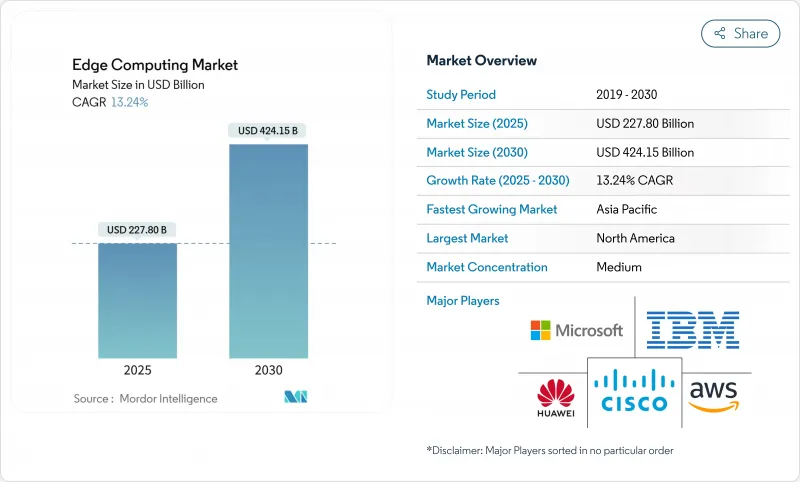
|
市場調査レポート
商品コード
1851015
エッジコンピューティング:市場シェア分析、産業動向、統計、成長予測(2025年~2030年)Edge Computing - Market Share Analysis, Industry Trends & Statistics, Growth Forecasts (2025 - 2030) |
||||||
カスタマイズ可能
適宜更新あり
|
|||||||
| エッジコンピューティング:市場シェア分析、産業動向、統計、成長予測(2025年~2030年) |
|
出版日: 2025年06月23日
発行: Mordor Intelligence
ページ情報: 英文 120 Pages
納期: 2~3営業日
|
概要
エッジコンピューティングの市場規模は2025年に2,278億米ドルと推定され、2030年には4,241億5,000万米ドルに達する見込みで、CAGRは13.24%で推移しています。

ネットワークエッジにおけるデータ重量の増大、5G無線アクセスネットワークの展開、世界的なデータ主権義務化により、時間的制約のある処理を集中型クラウドから移行することで、企業アーキテクチャが再定義されつつあります。ハードウェアベンダーは、リアルタイムAI推論への参入障壁を下げるASICとSoCの価格下落から恩恵を受け、通信事業者はETSIフェーズ4仕様に沿ったマルチアクセスエッジコンピュート(MEC)サービスを通じて新たな収益源を開拓します。製造、エネルギー、モビリティの各分野の企業は、レイテンシーを最小限に抑え、機密データを保護し、運用の耐障害性を向上させるためにエッジノードを採用しています。同時に、クラウド・ハイパースケーラはマネージド・サービスを顧客構内まで拡張し、分散ワークロードの統合的な観測とライフサイクル管理を可能にします。
世界のエッジコンピューティング市場の動向と洞察
超低遅延の使用事例を促進する5Gの展開
世界的な5Gの展開により、自律走行車、遠隔手術、没入型メンテナンス・アプリケーションが必要とするミリ秒以下のレイテンシが可能になります。VerizonとNVIDIAは、プライベート5Gネットワーク上でリアルタイムのAIサービスを試験的に開始し、厳しい往復遅延バジェットを満たすために基地局にエッジノードを固定しています。ハイパースケーラは現在、通信交換機にマイクロデータセンターをコロケーションしており、開発者はコンテナをユーザーに近づけることができます。ETSI MECフェーズ4プロファイルは、共通のAPIを作成し、オペレータがワークロードの移植性を確保しながら、差別化された遅延ティアを収益化するのに役立ちます。投資サイクルは、政府が地方の5Gカバレッジに資金を提供し、密集した都市の回廊を越えてエッジ駆動型サービスを拡張するのと一致しています。
IoTエンドポイントの急増とデータグラビティ
産業現場には数千ものセンサーが設置され、毎日何テラバイトものデータが流れています。製造業者の89%は、リアルタイムの品質管理のためにAI推論をローカル・ゲートウェイに移行する意向を示しています。エッジ・ネイティブ・アーキテクチャは帯域幅のコストを削減し、要約されるまで大量のデータをオンサイトで保持することでクラウドへの接続料金を回避します。TCSクレバーエナジーのようなプラットフォームは、ローカル推論を使用して異常にフラグを立て、即座に是正措置を発動します。IoTデバイスは軽量のGPUやNPUを統合しているため、ビジョンモデルを自律的に実行することができ、監視タスクのためにバックホール回線を解放することができます。
分散ノードにおけるサイバー攻撃表面の拡大
すべてのゲートウェイ、センサー、マイクロデータセンターが潜在的な侵入ポイントとなり、IT/OTネットワークに横展開される可能性が高まります。産業オペレータは、ゼロトラスト・ファームウェア、ハードウェア・ルート・オブ・トラスト、TPMバックド認証を導入しているが、後付けされたレガシー・デバイスは、セキュアなブート・シーケンスがないことが多いです。エッジノードが保護されたデータセンター構内を離れ、工場のフロアや道路脇のキャビネットに存在するようになると、物理的な改ざんリスクは上昇します。ローカルで動作するリアルタイムのフォレンジックツールが不足しているため、インシデントレスポンスに支障をきたし、侵害を封じ込めるまでの平均時間が長くなっています。
セグメント分析
ハードウェアは、2024年のエッジコンピューティング市場の45.2%を占め、これは堅牢化されたサーバー、アクセラレーター、フィールド展開可能なストレージに必要な先行投資を反映しています。ハードウェアのエッジコンピューティング市場規模は2025年に1,028億米ドルに達し、ASICの価格下落に伴って堅調な成長が見込まれます。ソフトウェア・プラットフォームは、オーケストレーション・スタックにAIモデルのライフサイクル管理とリモート観測機能が追加されたため、収益では後塵を拝しているが革新性ではリードしており、CAGRは最高13.7%を記録しました。サービス部門の売上は控えめだが、レガシーPLCの統合やブラウンフィールド工業用地内のリアルタイムオペレーティングシステムへの対応など、必要不可欠なものです。
チップメーカー間の熾烈な競争が単価を引き下げ、産業用温度範囲に耐える低消費電力AI推論カードの大量導入を可能にします。インテルの18Aロードマップはトランシーバー密度を向上させ、インテリジェント・ゲートウェイの決定論的スループットを高める。同時に、アドバンテックとナムラが提供するゼロタッチ・デプロイメント・フレームワークは、ノードのプロビジョニングを自動化することで統合コストを削減し、ハードウェアを包み込むマネージド・サービスの今後の成長を示唆しています。
2024年のエッジコンピューティング市場では、オンプレミス・ソリューションが67.2%を占める。ハイブリッドクラウドのエッジはCAGR 14.9%で急成長し、企業はハイパースケールクラウドでの中央モデルトレーニングとファクトリーセルでの分散推論を採用します。企業はワークロードの階層化を試験的に導入し、リアルタイムの推論をローカルで実行し、緊急性のない分析は夜間に地域のアベイラビリティゾーンにバックホールします。
エアギャップのあるクルーズ船の決済システムは、衛星回線に障害が発生した場合でも運用を継続するオンプレミスの弾力性を示しています。逆に、マイクロソフトのArmadaへの投資は、クラウドとエッジにまたがる統合コントロールプレーンが長期的に勝利するというハイパースケーラの確信を反映しています。ベンダーは現在、クラウド・コンソールに事前登録されたアプライアンスを出荷しており、単一サイトのPOCから複数国の拠点への摩擦のない拡張を可能にしています。
エッジコンピューティング市場は、コンポーネント別(ハードウェア、ソフトウェア、サービス)、デプロイメント別(オンプレミス、クラウド)、エンドユーザー産業別(製造・産業、エネルギー・公益事業、その他)、アプリケーション別(産業用IoT、予知保全、その他)、組織規模別(大企業、中小企業)、地域別に分類されています。市場予測は金額(米ドル)で提供されます。
地域別分析
北米は2024年にエッジコンピューティング市場の24.8%を占め、堅調な5G展開、広大なハイパースケーラの設置面積、半導体生産への公的資金投入がその要因となっています。バイデン政権は、国内のエッジハードウェア能力を強化するマイクロエレクトロニクスプログラムに2億6,900万米ドルを割り当てた。米国では公益事業がプライベートLTEと堅牢なMECノードを導入してグリッド運用を近代化しており、2025年までに企業で生成されるデータの75%はソースにとどまるか、ソースの近くにとどまると予測されています。カナダもこれに続き、WANの待ち時間を許容できない自律的な採鉱やエネルギーワークフローをターゲットにしています。
アジア太平洋地域は、2030年までのCAGRが15.1%で、最も急成長している地域です。中国の「新インフラ」政策は、製造クラスターの近くにエッジデータセンターを構築することを奨励し、ファーウェイは2024年の収益の20.8%をAI、自動車、クラウドサービスにまたがる研究開発に投資しました。インドのスマートシティプログラムはエッジ対応の監視と交通最適化を統合し、日本の大手オートメーション企業は決定論的イーサネットとTSNを生産ラインに組み込んでいます。地域の通信事業者は、積極的なファイバー敷設を活用してエッジアグリゲートをメトロコアにバックホールし、没入型ゲームやテレプレゼンスのジッターを最小限に抑えています。
その他の特典:
- エクセル形式の市場予測(ME)シート
- 3ヶ月間のアナリストサポート
よくあるご質問
目次
第1章 イントロダクション
- 調査の前提条件と市場の定義
- 調査範囲
第2章 調査手法
第3章 エグゼクティブサマリー
第4章 市場情勢
- 市場概要
- 市場促進要因
- 超低遅延の使用事例を促進する5Gの展開
- エッジにおけるIoTエンドポイントとデータ重力の急増
- データ主権に関する規制(EUデータ法など)
- エッジ推論アクセラレータのASIC/SoCコストの低下
- マイクロデータセンターを牽引するエネルギー効率目標(ESG)
- カスタムエッジシリコンを可能にするRISC-Vとチップレットアーキテクチャの台頭
- 市場抑制要因
- 分散ノードにおけるサイバー攻撃表面の拡大
- 異種エッジスタックの導入と管理におけるスキル格差
- 相互運用性と規格の断片化(MEC、Open-RAN、LF Edge)
- ブラウンフィールド工業用改修のROIの低さ
- サプライチェーン分析
- テクノロジーの展望
- 規制情勢
- ポーターのファイブフォース分析
- 供給企業の交渉力
- 買い手の交渉力
- 新規参入業者の脅威
- 代替品の脅威
- 競争企業間の敵対関係
- 市場に与えるマクロ経済要因の評価
第5章 市場規模と成長予測
- コンポーネント別
- ハードウェア
- ソフトウェア
- サービス
- 展開モード別
- オンプレミス
- クラウド
- エンドユーザー業界別
- 製造業と工業
- エネルギーと公益事業
- ヘルスケアとライフサイエンス
- 小売とeコマース
- BFSI
- IT・通信
- その他
- 用途別
- 産業用IoTと予知保全
- ビデオ分析と監視
- 自律走行車とドローン
- その他
- 企業規模別
- 大企業
- 中小企業
- 地域別
- 北米
- 米国
- カナダ
- メキシコ
- 南米
- ブラジル
- アルゼンチン
- その他南米
- 欧州
- ドイツ
- 英国
- フランス
- イタリア
- スペイン
- ロシア
- その他欧州地域
- アジア太平洋
- 中国
- 日本
- インド
- 韓国
- オーストラリアとニュージーランド
- 東南アジア
- その他アジア太平洋地域
- 中東・アフリカ
- 中東
- サウジアラビア
- アラブ首長国連邦
- トルコ
- その他中東
- アフリカ
- 南アフリカ
- ナイジェリア
- エジプト
- その他アフリカ
- 北米
第6章 競合情勢
- 市場集中度
- 戦略的動向
- 市場シェア分析
- 企業プロファイル
- Amazon Web Services(AWS)
- Microsoft Corporation
- Cisco Systems Inc.
- Huawei Technologies Co. Ltd.
- IBM Corporation
- Hewlett Packard Enterprise(HPE)
- Dell Technologies Inc.
- Google LLC(Alphabet Inc.)
- Intel Corporation
- NVIDIA Corporation
- Juniper Networks Inc.
- Advantech Co. Ltd.
- ADLINK Technology Inc.
- Schneider Electric SE
- Siemens AG
- Capgemini Engineering
- EdgeIQ(MachineShop Inc.)
- Vapor IO Inc.
- Litmus Automation
- FogHorn Systems
- Lumen Technologies Inc.

